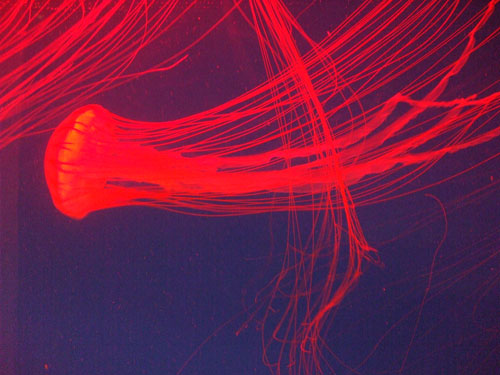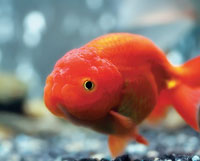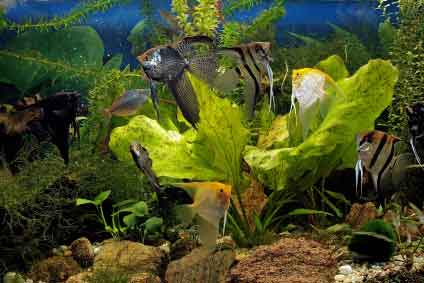
It may not be easy to source the fish for these tanks, but several dealers and stores do import Congolese fish, which normally include the species listed in these sample aquariums. The fish sizes are approximate — and can be reached by the fish in these tanks if they are properly maintained.
Malebo Pool Congo River Aquarium
Size: 65 gallons (48-by-18-by-18 inches)
Water: pH near neutral, medium hardness, 82 degrees Fahrenheit
Filtration: Large-volume canister filter, weekly 50-percent water changes
Aquascaping: Fine sand, sandstone rocks, some driftwood. While they are not normally found here, the West African plants Anubias barteri and Crinum natans will do well in this setup.
Food: High-quality flake food, frozen bloodworm, brine shrimp, live blackworm and earthworms
Fish: Six Congo tetras (Phenacogrammus interruptus), 7 inches; six upside-down catfish (Synodontis nigriventris), 3 inches; four Synodontis schoutedeni or S. contractus, 5 inches; six Peter’s elephantnoses (Gnathonemus petersii) or Campylomormyrus tamandua, 7 inches; four freshwater butterflyfish (Pantodon buchholzi), 5 inches; eight orange bushfish (Microctenopoma ansorgii), 3 inches
With half of these 34 fish in total being nocturnal, this aquarium will be interesting even after the lights are off. All species are quite easy to keep with the exception of the food. The elephantnose and bushfish will prefer frozen and occasionally live food, while the butterflyfish must get enough opportunity to feed along the surface. There are no cichlids in this aquarium, allowing the shy bushfish more space for their territories along the bottom that would otherwise be dominated by the cichlids. The bushfish could be replaced with a pair of jewel cichlids (Hemichromis stellifer) or Tilapia. Also well suited would be Nanochromis parilus, which normally occur more frequently in the rapids.
Congo River Rapids Aquarium
Size: 108 gallons (72-by-18-by-20 inches)
Water: pH near neutral, medium hardness, 78 degrees Fahrenheit
Filtration: Large-volume canister filter, at least two large powerheads to create directional current from one side to the other. Weekly 50 to 70-percent water changes.
Aquascaping: Thin layer of fine sand. Sandstone rocks piled almost to the surface. No plants — there are none present in the rapids, and they would be eaten by the fish.
Lights: At least four HO fluorescent tubes to stimulate the growth of algae to supplement the diet of the rheophile fish.
Food: High-quality flake food, sinking pellets, frozen peas, frozen brine shrimp, bloodworm and krill.
Fish: Six buffalohead cichlids (Steatocranus casuarius or S. gibbiceps), 4 inches; six slender buffaloheads (Steatocranus tinanti), 4 inches; four Teleogramma brichardi or T. monogramma, 5 inches; four Lamprologus werneri or L. congoensis, 6 inches; four Synodontis brichardi or S. angelicus, 6 inches; six S. flavitaeniatus, 4 inches; four Labeo cyclorhynchus or Garra species (to eat algae), 6 inches; four Distichodus sexfasciatus or any other Distichodus, 8 inches
This totals 38 fish in a rheophile community. The key here is current: It must be strong enough to push fish that venture into the open water to the other side of the tank. This stimulates natural behaviors of the current-loving species and greatly reduces intraspecific aggression. The personable buffalohead cichlids should be able to breed and raise young in the aquarium. Many of these fish are expert jumpers, so the tank must be well-covered.
 Proper Aquarium Lighting for your Aquarium Application
Lighting, just like filtration and heating, is an essential
Proper Aquarium Lighting for your Aquarium Application
Lighting, just like filtration and heating, is an essential
 UV Sterilizers and Freshwater Discus Aquariums
Q. I have a 90-gallon freshwater aquarium that is bare-
UV Sterilizers and Freshwater Discus Aquariums
Q. I have a 90-gallon freshwater aquarium that is bare-
 Finding Fancy Goldfish
Trying to find nice fancy goldfish like this in stores c
Finding Fancy Goldfish
Trying to find nice fancy goldfish like this in stores c
 Aquarium Fish Hiding Places
Imagine having to spend an extended period in a room w
Aquarium Fish Hiding Places
Imagine having to spend an extended period in a room w
 Hiding Fish
A common complaint, especially with new hobbyists, is, &
Hiding Fish
A common complaint, especially with new hobbyists, is, &
Copyright © 2005-2016 Pet Information All Rights Reserved
Contact us: www162date@outlook.com